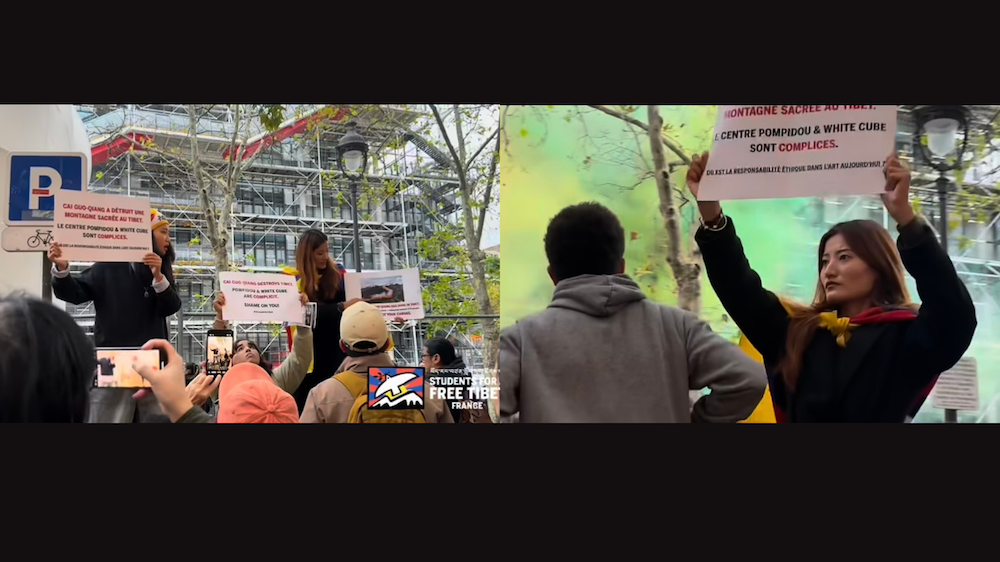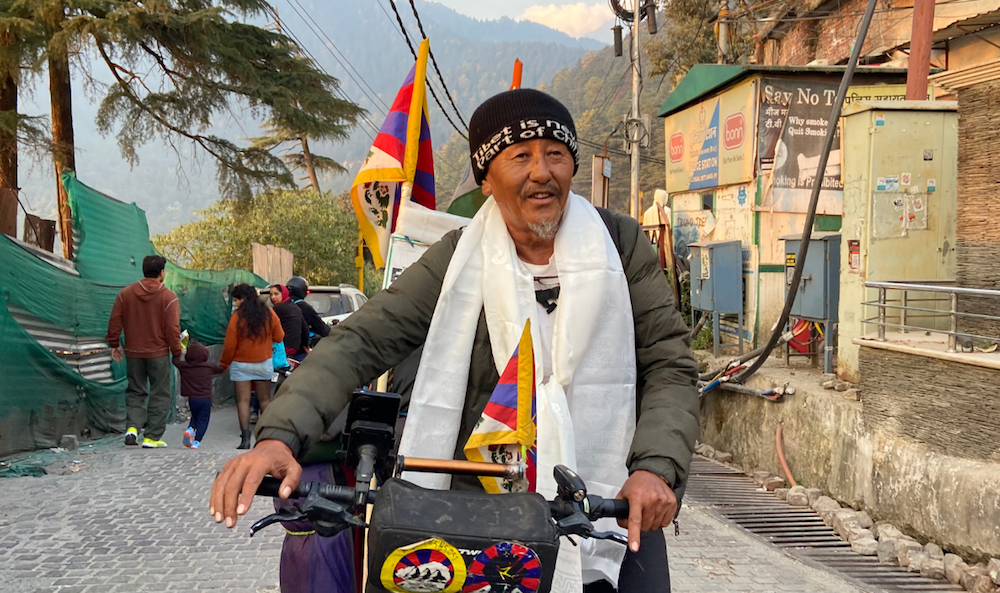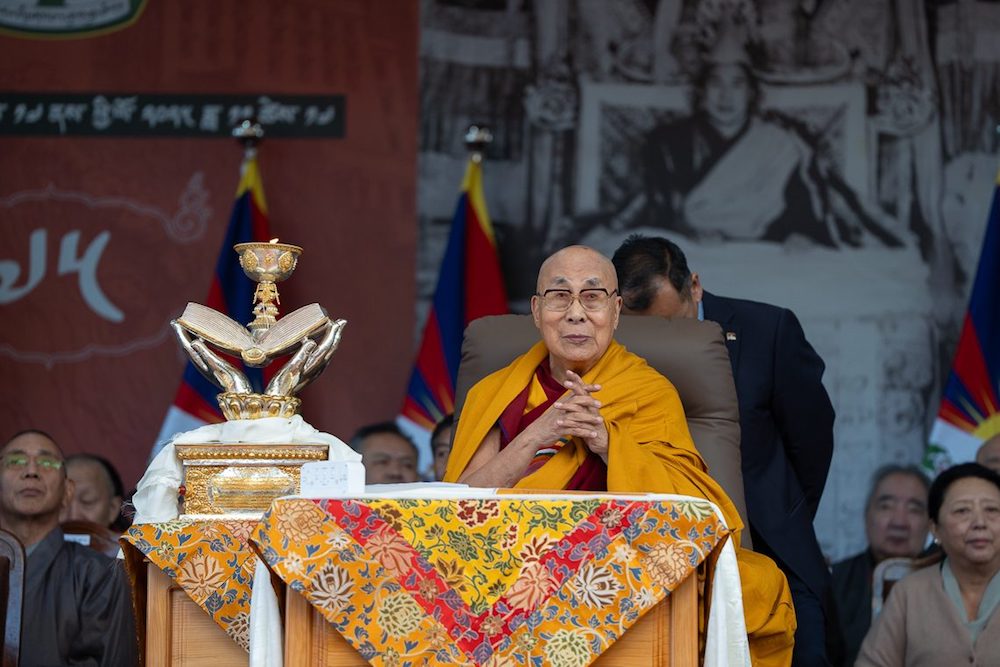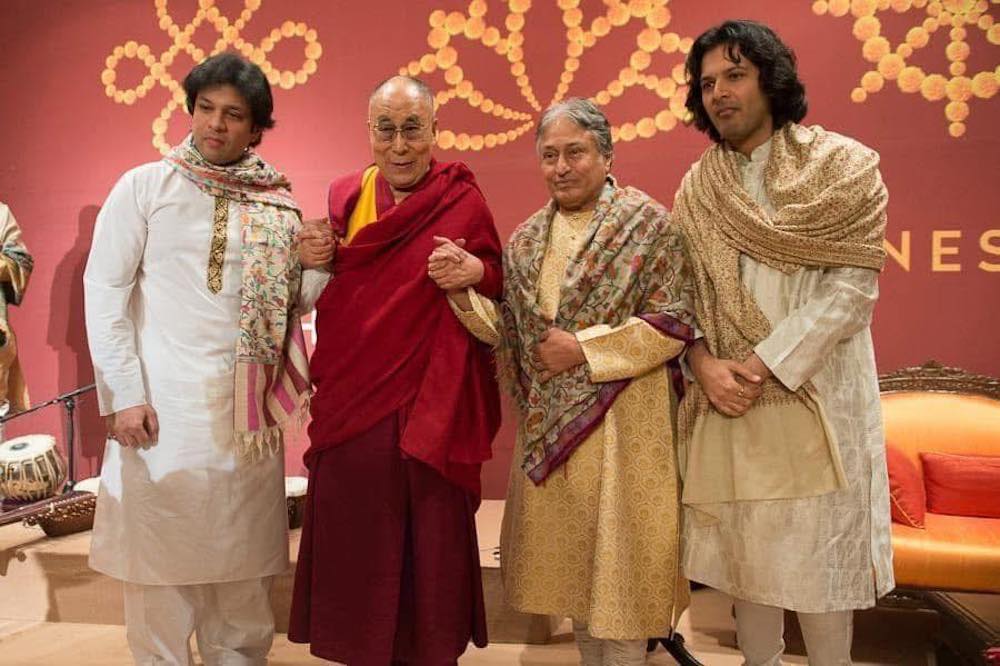Tenzin Nyidon
DHARAMSHALA, Oct. 24: Students for a Free Tibet (SFT) France staged a protest at the Pompidou Centre in Paris on Thursday, condemning the French contemporary art institution for celebrating Chinese artist Cai Guo-Qiang, whose recent firework display in Tibet triggered widespread environmental and ethical criticism.
The Pompidou Centre, in collaboration with one of the world’s leading contemporary art galleries, White Cube gallery, is currently showcasing Cai Guo-Qiang’s work, portraying him as a pioneering figure in contemporary art. However, Tibetan activists have denounced the celebration, citing his controversial project in Tibet that caused significant ecological harm and cultural insensitivity.
On September 19, Cai Guo-Qiang, in partnership with the Canadian outdoor clothing brand Arc’teryx, executed a massive firework explosion on sacred mountains in Shigatse, Tibet, as part of a commercial advertisement. The large-scale pyrotechnic display, conducted on fragile high-altitude terrain, left behind substantial debris, including remnants of explosive shells and plastic fragments. Local Tibetans were reportedly left to clean up the aftermath of the event without acknowledgement or support from the organizers.
Despite this, the Pompidou Centre and White Cube chose to celebrate Cai as an innovator who bridges “tradition and modernity” through his use of gunpowder and explosives to create art. His exhibition has been described by the institutions as a reflection on “humanity’s relationship with nature and the cosmos,” a framing that critics say blatantly ignores the environmental destruction and cultural disrespect involved in his Tibetan project.
SFT France during the protest condemned both institutions for turning a blind eye to the artist’s actions and for “glorifying destruction under the guise of creativity.” “To celebrate an artist who destroys the land of people is to be an accomplice,” SFT France declared. “Tibet is a living, sacred, spiritual land. And no one has the right to set it on fire — not even in the name of art. We are here to remind you of the truth: Tibet is not a setting, and spirituality is not a marketing product. Art without ethics is disguised power. We denounce their complicity in this symbolic and environmental violence. We demand clear answers and an assumed position from White Cube and the Pompidou Centre.”
SFT France called on both art institutions to publicly acknowledge the harm caused by Cai Guo-Qiang’s project in Tibet and to take a stand against the exploitation of occupied lands for commercial and artistic gain.











2 Responses
The above person knows nothing about the protest that took place and spreads his half-truths. SFT France was there with pamphlets in English and in French. The activists, both French and Tibetans talked with many people who were present at this show in front of the Pompidou.
This person should try to first seek the truth, know the complete picture and stop preaching without leaving his chair.
Encourage the young Tibetans and French supporters, who showed up to protest.
A friend, who knows how deeply I am connected to France, sent me this article and asked for my reaction. (en anglais puis en français (mon texte d‘origine))
Here is my response: simple, clear, direct and honest.
If some find it uncomfortable, so be it: certain truths must be spoken.
https://www.phayul.com/news/
The demonstration by “Students for a Free Tibet” in Paris is one thing.
But the main issue is the decision of the Centre Pompidou to invite and celebrate the so-called Chinese artist who defiled the Tibetan soil.
Yes, I saw the news.
And it is important to understand that this is not simply about contemporary art or artistic freedom.
Protesting in front of the Pompidou, without clearly explaining what is at stake, leaves most of the public confused. It is essential to speak to the French people, and to do so in French, because it is the citizens of this country who can influence its cultural and diplomatic choices. Without clear words, the message does not reach its destination. To be heard in France, one must speak to the French public, in their language, and the message gains even more strength when French citizens stand with us.
Cai Guo-Qiang’s fireworks in Tibet were carried out on a sacred mountain, in an occupied land, without the consent of the people who live there, in an environment already deeply damaged by policies imposed by the occupying power.
This gesture was not neutral.
It raises three essential questions.
The first is environmental.
The Tibetan plateau is already under intense pressure: mining extraction, industrial development, large dams on rivers, heavy militarization. Adding pyrotechnic explosions and chemical residues in such an ecologically fragile region is not an aesthetic detail. It is an additional act of violence against an already wounded land.
The second is ethical.
Turning Tibet into a spectacular backdrop, in poor taste, while excluding the voice of even one Tibetan, is an act of erasure.
It erases the Tibetan people, their culture, their soul.
Under the cover of art.
A smoke-screen for the policy of sinicization.
“When the culture of a people is destroyed, it is their very soul that one attempts to erase.”
His Holiness the Dalai Lama
The third is political.
Cai Guo-Qiang is not a free artist. He is linked to the power of the Chinese Communist Party, and his work aligns with that power. His interventions in politically sensitive regions such as Tibet take part in a cultural staging that reinforces the occupation: presenting the illusion of a harmonious, peaceful, integrated Tibet, while the reality is dispossession, surveillance and control. This contributes to the official narrative of a Tibet emptied of Tibetans.
In this context, the fact that the Centre Pompidou, a French public institution, chooses to celebrate this artist without questioning the meaning of his action is deeply concerning. Whether intentionally or not, it legitimizes a vision that denies the presence, memory and voice of the Tibetan people.
When the voice of a people is erased, it is not peace that follows, but enforced oblivion.
And we, Tibetans, refuse to disappear.
SFT was right to protest.
But the action needed to be accompanied by strong explanations, a clear statement, arguments understandable to the public. Phayul relaying the action may inform Tibetans, but the goal here was to speak to French society. And the denunciation needed to be explicit: it is the Centre Pompidou that chose to invite and celebrate this artist, despite the political and symbolic meaning of his act in Tibet.
The issue was not simply to be visible.
The issue was to name the injustice.
Protesting is one step.
Explaining is a responsibility.
Building understanding is a deeper commitment.
We are not speaking about a performance.
We are speaking about of a threatened people.
Long Live Tibet,
Long Live the Tibetan People!
The Little Silly Tibetan, Ugen
Artist and art therapist through painting,
གུས་བོད་པའི་གླེན་ཆུང་ནུབ་པ་ཨོ་རྒྱན་ནས།
Vice-President of the Association France-Tibet
EN FRANÇAIS
Un ami, qui sait combien je suis profondément lié à la France, m’a envoyé cet article et m’a demandé ma réaction.
Voici ma réponse, simple, claire, directe et honnête.
Si cela froisse certains, tant pis : certaines vérités doivent être dites.
https://www.phayul.com/news/
La manifestation des « Étudiants pour un Tibet Libre » à Paris est une chose.
Mais l’enjeu principal est la décision du Centre Pompidou d’inviter et de célébrer le prétendu artiste chinois qui a sali le sol du Tibet.
Oui, j’ai vu passer cette information.
Et il faut comprendre qu’il ne s’agit pas seulement d’art contemporain ou de liberté de création.
Manifester devant le Centre Pompidou, sans expliquer clairement ce qui est en jeu, laisse la majorité du public dans l’incompréhension. Il est indispensable de s’adresser aux Français, et en français, parce que ce sont les citoyens de ce pays qui peuvent agir sur leurs institutions culturelles et leur diplomatie. Sans parole claire, le message ne circule pas. Pour être entendus en France, il faut parler au peuple français, dans sa langue, et il est encore plus puissant lorsque des Français se joignent à nous.
Le feu d’artifice de Cai Guo-Qiang au Tibet a été réalisé sur une montagne sacrée, dans un pays occupé, sans consentement du peuple qui y vit, dans un environnement déjà profondément fragilisé par des politiques imposées par la puissance occupante.
Ce geste n’était pas neutre.
Il soulève trois questions essentielles.
La première est environnementale.
Le plateau tibétain subit déjà des pressions extrêmes : extraction minière, industrialisation, barrages sur les fleuves, militarisation. Y ajouter des explosions pyrotechniques et des résidus chimiques, dans une région écologique aussi fragile, n’a rien d’anodin. C’est une violence supplémentaire infligée à une terre déjà blessée.
La deuxième est éthique.
Faire du Tibet un décor esthétique, d‘un goût douteux, sans la voix d’un seul Tibétain, revient à effacer un peuple vivant.
C’est un effacement du Tibet, de sa culture, de son âme.
Sous couvert d’art.
Un écran de fumée de la politique de sinisation.
« Quand la culture d’un peuple est détruite, c’est son âme même que l’on tente d’effacer. »
Sa Sainteté le Dalaï-Lama
La troisième est politique.
Cai Guo-Qiang n’est pas un artiste libre. Il est lié au pouvoir du Parti communiste chinois, et son travail s’inscrit dans cette ligne. Ses interventions dans les régions sensibles comme le Tibet participent d’une mise en scène qui accompagne l’occupation : donner l’illusion d’un Tibet harmonieux, intégré, paisible, alors qu’il y a dépossession, surveillance et contrôle. Ce geste contribue à la narration officielle d’un Tibet vidé des Tibétains.
Dans ce contexte, que le Centre Pompidou, institution publique française, choisisse de célébrer cet artiste sans interroger le sens profond de son action est extrêmement préoccupant. Cela revient, volontairement ou non, à valider une vision qui nie la présence, la mémoire et la voix du peuple tibétain.
Quand la parole d’un peuple est effacée, ce n’est pas la paix qui s’installe, mais l’oubli imposé.
Et nous, Tibétains, refusons cet oubli.
SFT a raison de manifester.
Mais il fallait accompagner cette action d’une explication solide, d’un communiqué clair, d’arguments compréhensibles pour le public. Que Phayul relaie l’événement permet aux Tibétains de le voir, mais l’objectif ici était de parler à la société française. Et la dénonciation devait être explicite : c’est le Centre Pompidou qui a choisi d’inviter cet artiste, malgré le sens politique et symbolique de son geste au Tibet.
L’enjeu n’était pas simplement d’être visibles.
L’enjeu était de nommer l’injustice.
Manifester est une étape.
Expliquer est une responsabilité.
Construire la compréhension est un engagement plus profond.
Nous ne parlons pas d’un spectacle.
Nous parlons d’un peuple menacé.
Vive le Tibet,
Vive le Peuple Tibétain!
Le P’tit bêtain Ugen,
Artiste et art-thérapeute par la peinture,
གུས་བོད་པའི་གླེན་ཆུང་ནུབ་པ་ཨོ་རྒྱན་ནས།
Vice-Président de l’Association France-Tibet